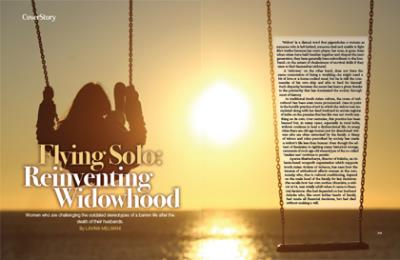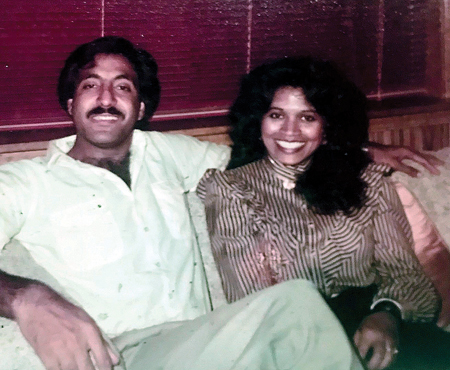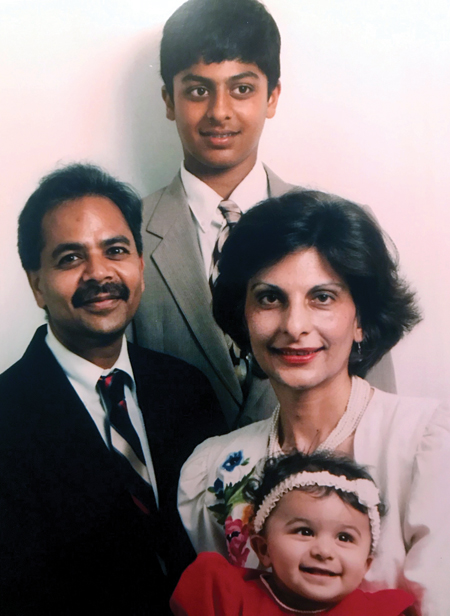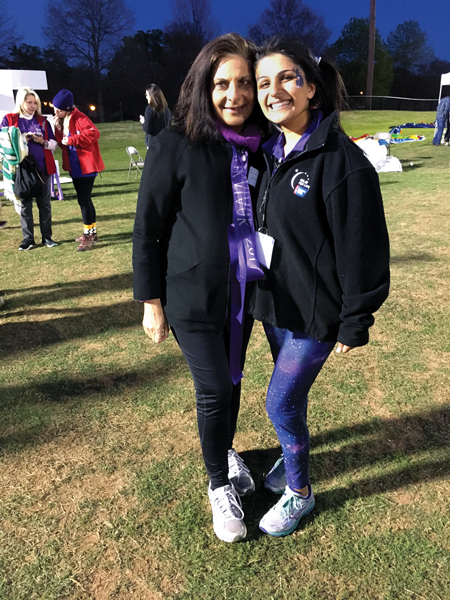Flying Solo: Reinventing Widowhood

‘Widow’ is a dismal word that pigeonholes a woman as someone who is left behind, someone frail and unable to fight life’s battles because her main player, her man, is gone. Even when wives have held families together and shaped the next generation, they have generally been subordinate to the husband— to the extent of cluelessness of survival skills if they were to find themselves widowed.
A ‘widower,’ on the other hand, does not have the same connotation of being a weakling—he might need a bit of love or a home-cooked meal, but he is still the commander of his own ship and able to fend for himself. Such disparity between the sexes has been a given thanks to the patriarchy that has dominated the society through most of history.
In traditional South Asian culture, the curse of widowhood has been even more pronounced. Case in point is the horrific practice of sati in which the widow was immolated along with her dead husband in certain regions of India on the premise that her life was not worth anything on its own. Over centuries, this practice has been banned but, in many cases, especially in rural India, widows continue to lead a dysfunctional life. In many cities there are old-age homes just for abandoned widows who are often ostracized by the family. A litany of taboos and rules prescribed by society has made a widow’s life less than human. Even though the advent of feminism is righting many historical wrongs, remnants of such age-old stereotypes of the so-called ‘weaker sex’ continue to persist.
Aparna Bhattacharya, director of Raksha, an Atlanta- based nonprofit organization which supports South Asian victims of violence, has seen how the trauma of widowhood affects women in the community who, due to cultural conditioning, depend on the male head of the family for key decisions. She recalls how her own mother Shumitra, a widow at 54, was totally adrift when it came to financial decisions. She had depended on her husband Ashoke who, like most Indian heads of family, had made all financial decisions, but had died without making a will.
 [Right] A young Bhattacharya (center) with her sister and parents, from their early years in the U.S.
[Right] A young Bhattacharya (center) with her sister and parents, from their early years in the U.S.
How Shumitra eventually found strength and independence in widowhood speaks of the change that is in the air. Even in India, where just 50 years ago, widows were expected to wear white all their lives and abstain from joy and happy occasions, they are realizing it’s hardly fair to penalize women for having lost their life companions and support. Widows are wearing colors and blending into the workforce, merging back into the world.
Here, the Indian-American community is a thriving one, but many thought processes and rituals are carried over in suitcases along with the spices and folklore. Although Indian women here struggle with the same tussle between traditional shackles and modern outlooks and opportunities, they tend to be more outspoken and proactive. Most have come here in traditional arranged marriages but have learned to take baby steps in leading independent lives—they are getting jobs, learning to drive, and even going for higher education. While bringing in a second income, these women have also been the nurturers, the community builders, the housekeepers, and the rollers of chapatis. These immigrant women have faced so many struggles in their lives that they seem to have a built-in gene for resilience. For these strong women, getting older or becoming widowed is a challenge—but one that they are able to face.
Bhattacharya says her mother was frustrated with her when she refused to take on the caretaker role left open after her father’s death, but, in the long run, was thankful that she had been pushed to make the tough decisions and gain her independence. After the initial shock, her mother managed the money and figured it all out because she had earlier worked in a bank and had also talked to her friends about financial matters. “Later she told me she had not believed she was capable of making those decisions,” recalls Bhattacharya.
“A lot has to do with what you believe you can do and picture yourself doing. Often fathers and husbands are the enablers—my mother had studied psychology in India, but her father had never allowed her to practice. I think women don’t understand the importance of knowing about money because they think their husbands are always going to take care of them. There are a lot of women to whom this is happening, and they’re not prepared because they’re not having these important discussions with their husbands.”
She adds, “In my experience of doing this work, I know it is important for families to have wills, to know about the finances, and to have access to the bank accounts and other financial resources. If Covid has taught us anything, it is that we need to be prepared for the unexpected. I also think it is important for women to have access to their own money.”
Speaking to such older immigrant women, one finds that for them, living totally alone is often fearsome: they go from their father’s home to their husband’s home. In India, after widowhood, many would live with their son’s family, occupied with grandchildren and family activities. Now, in an India that is changing fast, living in big extended families is becoming less common as the younger generation follows jobs to different cities or even abroad. Widows are increasingly having to learn to live alone. In the U.S., suddenly the widowed woman has to be the one behind the steering wheel, the one calling the shots. Fortunately, an increasing number of them are stepping up to this challenge.
 [Left] Sheela Puthumana and her husband Khurshid Ahmad, from their early days as a married couple.
[Left] Sheela Puthumana and her husband Khurshid Ahmad, from their early days as a married couple.
Muktiben* of New Jersey is 85 years old and has recently lost her husband who was 90 years old. She spent many years as a caregiver to him but before that, she worked in the American school system. She continues to drive and to live alone in her home in the suburbs even though she has an adult daughter and son, both living twenty minutes away. She prefers to live independently and meet her children and grandchildren as the matriarch of the family. They drop in, and other extended family members also check up on her, but she prefers to run her own ship. Recently she took her husband’s ashes to India and stayed with her extended family who fussed over her. Yet she’s back, even though America is a lonelier and harder existence—it is now her home and this is where her children are.
Kavita*, another woman in her 60s who got widowed last year in New York, continues to work and drive while maintaining her own home. But she spends the nights and shares her meals at her son’s home nearby. She gets to be close to the grandchildren and draw strength from her family. She has the best of
both worlds, as she bonds with her grandchildren yet retains her independent lifestyle, nonprofit work and large circle of friends. She is not defined by the word ‘widow’ as she continues to be a professional, a mother, a grandmother, and a volunteer in an education nonprofit.
Rita Sadhwani faced a different challenge. When she was in her 30s, she lost her husband. What made it even more challenging was the fact that he was in America while she had not even stepped into America. Her husband had come into the U.S. en route to Canada where his immigrant visa had been approved. But before he could travel to Canada, he had a massive heart attack right at JFK airport. He collapsed and died as he boarded a taxi.
A quick-thinking sister and brother-in-law in the U.S. immediately got the young widow and her children to travel from Mumbai to New York and then fly to Canada to use the visa. It was a nightmare journey for a docile woman with three small children to board a flight and take on a Canadian life back in the ‘90s. She was totally alone in Toronto with her kids and had to adapt to a new world. She had no car, no help, and not much money. But education was her strong card and she got a teaching job almost immediately.
Now nearly 30 years later, she says it was the best decision she made: she has had a good career in education while her three children are all grown with meaningful jobs and homes of their own. This life would not have been possible if she had remained in Mumbai, surrounded by over-controlling in-laws and conservative relatives. Says Sadhwani, “Before my marriage, I had done my masters and had a teaching degree but had never been allowed to use it. Even to attend a parent-teacher meeting in my children’s school, I had to get permission from my in-laws. It would have been a very different life for me and my children if I had never left Bombay. I would never have been able to shine or use my abilities.”
Sheela Puthumana, of Atlanta says, “I’m the poster child for what can go wrong. And, also of survival—I’m a poster child for that, too.” Puthumana had immigrated to the U.S. from Kerala in 1966 as a student on a scholarship to St. Francis University in Indiana. Here she, a Malayali Christian, met and married the love of her life, Khurshid Ahmad, a Sunni Muslim from Pakistan. The two, defying religious norms, were in a wonderful marriage for over 30 years. Her husband was a civil engineer, and she was the owner of a clinical diagnostic laboratory. They had a beautiful house, a young daughter, a flourishing lab, and had traveled the world twice over.
One day, in the course of a few minutes, this beautiful life evaporated. Early one morning, Ahmad was not feeling well and asked to be driven to the hospital. She recalls, “As I was driving, within five minutes of leaving the house, he took a deep breath and left the planet. He was just sitting there still. And I knew he was gone.” She rushed into a nearby gas station and being a medical technologist, gave him CPR as they laid him out on the cold concrete floor. “I knew he was gone but I kept trying, beating his chest, and trying to give him rescue breaths.”
The ambulance came but it was already too late for Ahmad who was just 56 years old. There was no chance of goodbyes for her or her 18-year-old daughter Sophia. Recalls Puthumana, “It was unbelievable! How you can just be thrown into something that you are not prepared for. I had not expected him to die. He exercised regularly, played golf, he was seemingly healthy.”
After Ahmad’s death, a total nightmare awaited mother and daughter. Puthumana had been so involved in running her lab, and Sophia so involved with her studies as a sophomore at Georgia Tech, that all financial affairs had been looked after by Ahmad. He had died without a will, and it turned out that the beautiful house that they lived in was only in his name. There was no life insurance and no mortgage insurance. Says Puthumana, “We were living like we’re gonna be here for 100 years. And then suddenly, everything came crashing down. I couldn’t access anything since my name was not on the property. He was paying all the bills. It was all in his head, and he died with all the usernames and passwords in his head.”
Suddenly—from difficulties in accessing the bank account to getting renters to pay the rent on their rental properties during the economic downturn of 2008—it all heaped on her plate. Her family and friends tried to help. “But I really went through hell,” Puthumana says. “I ended up having to foreclose on the rental properties. I had to file for bankruptcy for the lab because the debtors were coming to me left and right.”
Fortunately for her, after she sold the lab, her medical technologist skills landed her a well-paying job as a laboratory inspector with Atlanta’s regulatory agency. She was later promoted to director for licensing labs and radiology facilities for the state of Georgia. Her daughter Sophia’s education and skill with languages also got her employment with the government in Virginia. With Sophia’s help, she was able to hold on to the beautiful house her husband had bought for them. Today, mother and daughter continue to be a team that roots for each other and are friends who enjoy traveling together. “My daughter and I—we just never looked back, we just picked up the pieces and kept on marching,” says Puthumana.
 Life has a way of throwing fierce tsunamis at people—and Dr. Gulshan Harjee, also of Atlanta, had her share of the tsunami that wrecked her life after she lost her husband. An immigrant to America, she had fled from persecution in Tanzania and got her education in Pakistan and Iran before she earned her medical degree from Emory in Atlanta. Her job qualified her for a green card; and when she finished her residency, she opened a private practice. Her husband, Dean Delawalla from Pakistan, had been an immigration lawyer but had left his practice to start a business of medical supplies, while day trading on the side. He was Harjee’s best friend and support. They had one son and finally, after several miscarriages, had their daughter ten years later. Harjee is also a cancer survivor, having had systemic lupus which led to repeated miscarriages.
Life has a way of throwing fierce tsunamis at people—and Dr. Gulshan Harjee, also of Atlanta, had her share of the tsunami that wrecked her life after she lost her husband. An immigrant to America, she had fled from persecution in Tanzania and got her education in Pakistan and Iran before she earned her medical degree from Emory in Atlanta. Her job qualified her for a green card; and when she finished her residency, she opened a private practice. Her husband, Dean Delawalla from Pakistan, had been an immigration lawyer but had left his practice to start a business of medical supplies, while day trading on the side. He was Harjee’s best friend and support. They had one son and finally, after several miscarriages, had their daughter ten years later. Harjee is also a cancer survivor, having had systemic lupus which led to repeated miscarriages.
[Left] Dr. Gulshan Harjee with her husband, Dean Delawala, and children Faisal and Shahla—
in the ’90s
The day after her daughter’s fourth birthday, Delawalla was killed at the brokerage house by a deranged person who had gone on a shooting spree killing nine people and injuring many more. This rampage was the worst mass shooting in Atlanta’s history.
With that shooting, the world that Harjee and her husband had built so painstakingly, collapsed in those few surreal moments. The poignant obituary in The New York Times dated July 31, 1999, shows a glimpse of what Harjee had lost. “Mr. Delawalla, 52, made his living day trading, showing up almost every morning at the office park. But family and friends say day trading was just his job, not his life. His life, as they tell it, was his wife, Gulshan, a medical intern, and their two children, Faisal, 15, and Shahla, four.”
“The tendency for us is to block out painful incidents. I have very little recall of the funeral,” says Harjee. “All I remember is that there were massive numbers of cars, a massive number of people there. It was a huge funeral. And I think the city was also in shock—the whole city kind of just came to rescue us. There were so many memorial services, and the mayor came to several of those. It was just a very dark time in my life and for my children.”
“We were building a house at the time and it was almost ready. This was my husband’s dream house, and it’s painful to think about it even today. I had to keep going because I had two small children. I had a practice and I had this huge mortgage on a new house.”
For most Indian widows, family is the anchor which keeps them afloat whether it is video calls across continents or family members boarding a flight. Harjee’s extended family became her strength. Her mother, who had just then become a widow herself, came over from Canada to help her with the children so she could go back to work. She says, “My mother was still trying to learn to live a widow’s life herself and she dropped everything. My sister, who was a nurse in London, had moved here a year before. So, between my sister, my brother-in-law, and my mother, life just went on.”
Often, especially in close-knit communities like the Ismaili congregation, there is a lot of support. Says Harjee as she remembers the horrific days after her husband was shot, “I had a lot of emotional support from my whole neighborhood. I had to buy an extra fridge and put it in the garage so people could just come and load it any time. There were also so many messages, cards, flowers, and donations. It was so overwhelming. If I didn’t have the support of the community and of my siblings and my mother, I don’t know how I would have done this.”
Many widows also get an enhanced sense of purpose after realizing the arbitrary nature of the world. Harjee went on to have a successful medical profession and both her children are thriving in their chosen careers. She also turned the difficulties of her life—be it political persecution, financial hardships, or medical traumas like cancer—into learning blocks for bettering other people’s lives, be it refugees, immigrants, or medically challenged communities.

Harjee has won countless awards and accolades for her caring for the underserved and the forgotten. In 2013, she co-founded Clarkston Community Health Center where she serves as Chief Medical Officer on a pro bono basis. This free clinic provides primary and preventive care for the uninsured and economically challenged communities in the metro Atlanta area. She says, “This is where I heal—when I go to meet the widows, when I meet cancer survivors, when I can help immigrants and refugees and asylum seekers like myself, when I’m able to reach out and do things for them and lift them in their lives. That’s where I am healing as well.” Her latest project, a state-of-the-art patient comprehensive facility that will expand to a three-phase academic campus, will be located in the heart of Clarkston and will serve local marginalized communities.
[Right] A recent photo of Dr. Harjee with her daughter Shahla.
Love and remarriage are normally not within the plans of most Indian widows who have been conditioned to think of marriage as a forever bond which even death cannot change. While they travel, socialize, and work, most Indian widows shy away from new relationships or remarriage. Asha*, a doctor who lost her husband when she was in her 40s, is now in a relationship with a well-to-do young Indian but hesitates to give it an official title or even acknowledge it. Others go through marriages of expediency so that couples can have a new beginning and bring up their children in a new blended family.
As Indian-Americans adapt to the thought processes and lifestyles of America, their attitude towards widow remarriage is evolving too. Sheena*, 50, who recently lost her husband to cancer, is dealing with it in a very non-traditional way by seeing a bereavement counselor, interacting with a group of widows and widowers, and seeking companionship and new relationships.
Women are no longer the weaker sex as traditionally believed. As one listens to the stories of these women, one realizes they are definitely strong and resilient. Not too many men would be able to survive all that these women have endured—political persecution, health traumas, financial ruin, the death of their spouse, and bringing up their children single-handedly. Harjee agrees, “If you told a man that he may have cancer, his spouse is going to drop dead in front of him. I don’t think a man would be able to do that. They cannot connect with pain. Women’s emotional energies are different—the way we think, the way we prioritize is different.”
As pilots of their solo journeys, these women discover untapped reservoirs of strength and prove they can play the cards life has dealt them.
(*Names changed to protect privacy.)
Lavina Melwani is a NY-based journalist who writes for several international publications and blogs at Lassi with Lavina. This article was written with the support of a journalism fellowship from The Gerontological Society of America, The Journalists Network on Generations, and the Silver Century Foundation.
Enjoyed reading Khabar magazine? Subscribe to Khabar and get a full digital copy of this Indian-American community magazine.
blog comments powered by Disqus










